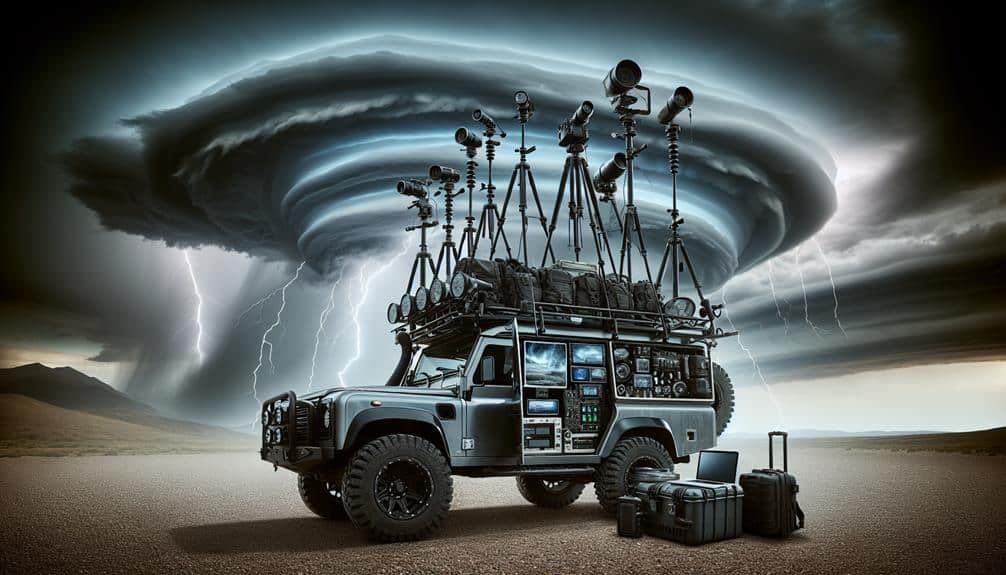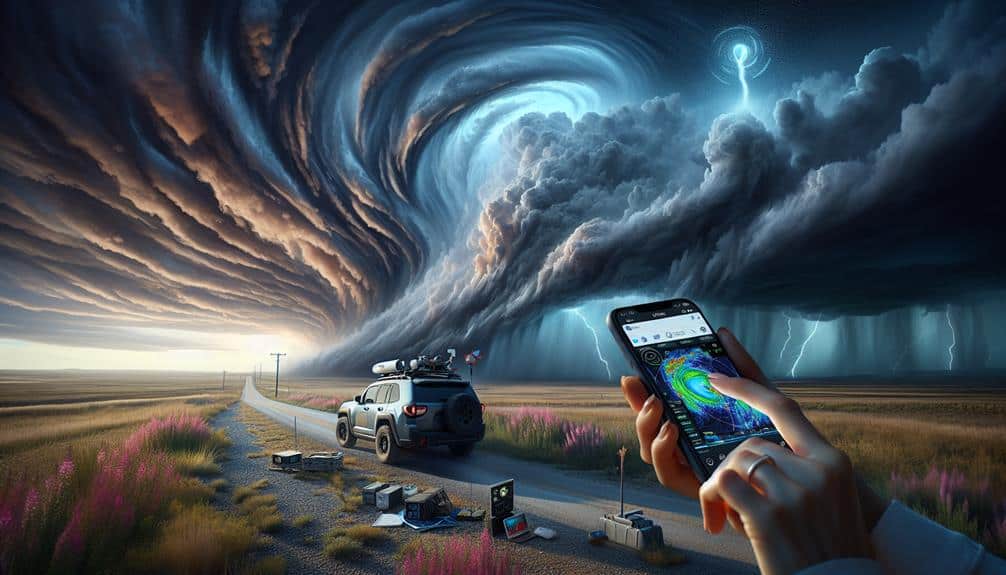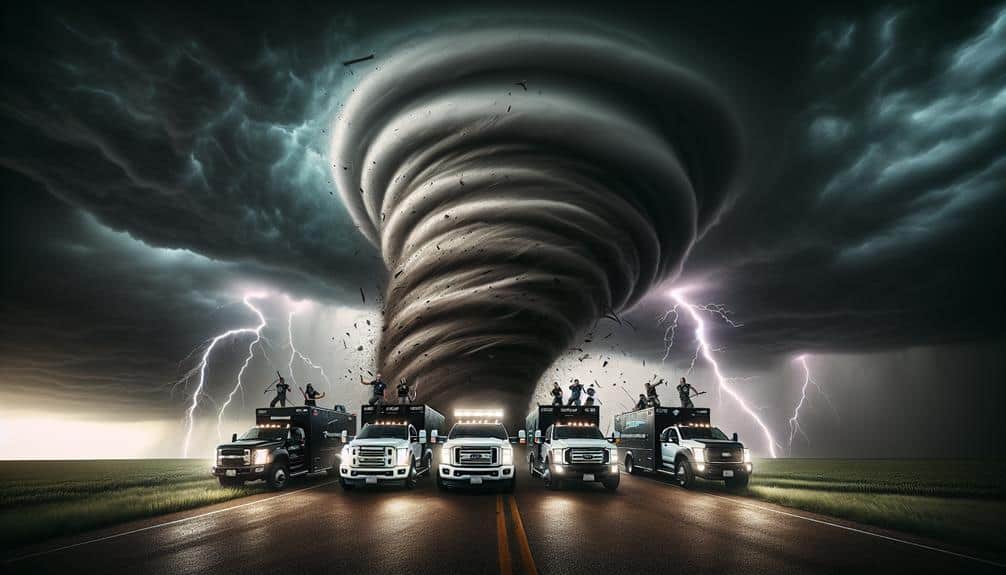We craft storm chasing road trip itineraries by analyzing historical weather patterns and using the latest meteorological data. For the peak season, we target April to June, focusing on Tornado Alley, from Oklahoma City to Wichita. Equipped with high-definition radar, reliable navigation systems, and essential emergency gear, we prioritize both safety and best storm viewing conditions. Key tools like RadarScope and NOAA forecasts keep us ahead of the storm's path. We also fine-tune photography settings for capturing dramatic weather phenomena. Our detailed strategies and precise tips will guide you towards an unforgettable storm-chasing adventure.
Key Points
- Identify peak storm chasing season (April to June) based on meteorological data and historical weather patterns.
- Prioritize high-activity zones like Tornado Alley, focusing on areas such as Oklahoma City, Moore, and Wichita.
- Equip vehicles with essential gear, including high-definition radar, navigation systems, and emergency supplies.
- Utilize advanced weather tracking tools like RadarScope and NOAA for real-time storm updates and informed decision-making.
Selecting the Best Season
Choosing the best season for storm chasing requires analyzing meteorological data to identify peak periods of severe weather activity. We've got to delve into historical weather patterns and current climatological forecasts to pinpoint the most favorable times.
Typically, the prime storm chasing season in the United States falls between April and June. During this period, the convergence of warm, moist air from the Gulf of Mexico and cool, dry air from the Rockies creates the perfect conditions for severe thunderstorms and tornadoes.
Storm chasing logistics also play a crucial role in our planning. By evaluating past storm reports and utilizing predictive weather models, we can maximize our chances of encountering significant storm systems. The Great Plains, often referred to as Tornado Alley, is our primary target zone. Here, meteorological phenomena such as supercells and squall lines are more prevalent.
Effective storm chasing demands that we stay informed about mesoscale and synoptic-scale weather patterns. Real-time data from sources like NOAA's Storm Prediction Center (SPC) provide essential updates. By understanding these patterns and aligning our schedules with peak storm activity, we guarantee that we're in the best position to witness nature's most powerful displays.
Mapping Out Key Locations
Let's identify the must-visit spots in Tornado Alley and pinpoint ideal storm viewing sites.
Based on historical tornado data, we'll focus on locations like Oklahoma City, Norman, and Wichita.
Utilizing meteorological tools, we can optimize our route for maximum storm observation opportunities.
Must-Visit Tornado Alley Spots
While mapping out key locations in Tornado Alley, we should prioritize high-activity zones like Oklahoma City, Moore, and Wichita due to their frequent severe weather events. These cities not only offer prime tornado-watching opportunities but also feature essential educational resources such as tornado museums and interactive experiences.
The National Weather Center in Norman, near Oklahoma City, provides invaluable data and exhibits that deepen our understanding of storm dynamics.
In Moore, we can visit the Orr Family Farm, which hosts various interactive experiences that bring the science of tornadoes to life. Wichita's Exploration Place offers another dimension of learning with its weather-related exhibits, making our trip both informative and exhilarating.
Storm chaser meetups in these high-activity zones present prime networking opportunities. Oklahoma City, in particular, frequently hosts such gatherings, allowing us to connect with seasoned storm chasers and meteorologists. These events offer firsthand insights and foster a sense of community among storm chasers.
Ideal Storm Viewing Sites
Mapping out key locations for storm viewing, we should focus on regions with a high frequency of severe weather events and accessible vantage points for safe observation. Our storm chasing strategies must prioritize both safety and excellent conditions for extreme weather photography.
Among the top destinations, Tornado Alley remains unparalleled. The stretch from Texas through Oklahoma, Kansas, and Nebraska offers a robust combination of frequent tornado occurrences and open landscapes, providing unobstructed views. Data from the NOAA indicates that Oklahoma experiences the highest concentration of tornadoes per square mile, making it an essential stop on our itinerary.
Moving beyond Tornado Alley, the Great Plains should also be on our radar. Eastern Colorado and western Kansas provide ideal conditions for supercell formation, which can produce photogenic storms. These areas offer the added advantage of vast, flat terrains that enhance our line of sight, minimizing obstructions.
For those seeking an adrenaline rush, Dixie Alley in the Southeastern U.S. presents a unique challenge. This region's complex terrain and dense vegetation require advanced storm chasing strategies but can reward us with dramatic storm structures and lightning displays.
Essential Gear and Equipment

To guarantee both safety and effectiveness during a storm chasing road trip, we need to equip ourselves with high-definition radar technology, reliable navigation systems, and durable communication devices. Investing in high-definition radar technology, like the ones available from RadarScope, enables us to track storm cells with precision, making sure we're always ahead of severe weather patterns.
Reliable navigation systems, such as Garmin or TomTom, are essential for navigating through unpredictable terrains. Emergency preparedness is vital. We should carry a complete first-aid kit, emergency blankets, and a multi-tool. Vehicle maintenance is essential; our vehicle should be equipped with a spare tire, jumper cables, and extra fuel containers.
Regularly checking tire pressure, oil levels, and brake functionality ensures our vehicle can handle challenging conditions. Effective communication devices, such as satellite phones and two-way radios, are crucial for staying in contact with team members and emergency services, especially in areas with poor cell reception.
Utilizing weather apps like WeatherBug and AccuWeather gives us real-time updates and alerts. High-capacity power banks and solar chargers ensure our devices remain operational. By combining these elements, we enhance our ability to chase storms safely and effectively, giving us the freedom to explore nature's most captivating displays.
Safety Tips and Guidelines
Equipped with the right gear, we must also adhere to strict safety protocols to lessen the risks associated with storm chasing. First and foremost, emergency preparedness is essential. We should identify and map out storm shelters along our route. Knowing the locations of these shelters allows for quick, decisive action should conditions deteriorate rapidly.
Next, we must establish strong communication plans. Keeping in contact with team members and local authorities ensures that everyone stays informed and coordinated. Each vehicle should be equipped with weather radios, which provide real-time updates from the National Weather Service. These radios are essential for staying ahead of rapidly changing weather conditions.
Additionally, we need to respect the power of nature. Maintaining a safe distance from the storm's core minimizes the risk of injury from hail, lightning, or tornadoes. Our vehicles should be fortified with safety features such as reinforced windows and emergency kits containing first aid supplies, water, and non-perishable food.
Finding Reliable Weather Updates

Accessing accurate and timely weather updates is important for making informed decisions during our storm chasing expeditions. Utilizing advanced weather tracking tools, we can pinpoint developing storm systems with precision. Websites and apps such as RadarScope and Weather Underground provide real-time radar imagery and detailed forecasts. These tools are essential for monitoring storm progression and identifying potential chase targets.
Storm prediction centers, like the National Weather Service's Storm Prediction Center (SPC), offer vital data on severe weather outlooks. The SPC's convective outlooks, mesoscale discussions, and tornado watches furnish us with extensive insights into where and when severe weather is most likely to occur. By analyzing these reports, we can optimize our routes and maximize our chances of encountering significant weather events.
Reliable forecasting sources, such as NOAA and the European Centre for Medium-Range Weather Forecasts (ECMWF), supply us with accurate and up-to-date information. Incorporating data from these sources ensures that our chase strategies are based on the most current meteorological data.
Additionally, subscribing to emergency alerts is important. Apps like FEMA and local alert services notify us of imminent severe weather, allowing us to make rapid, informed decisions to guarantee our safety while maintaining the freedom to pursue epic storm encounters.
Capturing the Perfect Storm Images
Let's focus on optimizing our camera settings to capture high-resolution storm images.
We'll also analyze the best timing for photographing storm formations and apply advanced composition techniques to enhance visual impact.
Ideal Camera Settings
To capture the ideal storm images, we'll need to adjust our camera settings for best exposure, focus, and stability. First and foremost, our exposure settings should be meticulously calibrated. A low ISO, around 100-200, minimizes noise and enhances detail, essential under variable lighting conditions.
Shutter speed depends on our desired effect: a faster speed (1/500s) freezes lightning, while a slower one (10-30s) captures its trails. Aperture settings around f/8 to f/11 strike a balance between depth of field and sharpness, optimizing our composition techniques.
Lighting conditions during storms can be unpredictable, oscillating between stark contrasts and dim subtleties. Using a tripod is non-negotiable for stability, allowing us to experiment with longer exposures without camera shake.
When it comes to lens choices, wide-angle lenses (14-24mm) are ideal for capturing expansive skies, ensuring the grandeur of the storm is fully conveyed. Telephoto lenses (70-200mm) can isolate distant elements, adding dramatic focus to lightning or cloud formations.
Manual focus is crucial; autofocus struggles in low light and can miss the mark. By fine-tuning these settings, we maximize our creative freedom, harnessing the storm's raw power in each frame.
Best Timing Tips
Timing our storm photography precisely is essential, as it allows us to capture the peak moments of atmospheric drama and lightning strikes. By leveraging advanced weather tracking and storm prediction tools, we can pinpoint the ideal times and locations for our shots. This precision is crucial for both safety and peak image quality.
We need road trip essentials that enable us to be both mobile and prepared. Key considerations include:
- Weather Tracking Apps: Utilize applications like RadarScope and Storm Radar to get real-time updates on storm movements and intensity.
- Portable Power Sources: Pack reliable power banks and car chargers to ensure our devices remain operational throughout the trip.
Storm prediction is an evolving science, and staying updated with the latest meteorological data is vital. We should always check the National Weather Service forecasts and other reliable sources before setting out.
Packing tips for a storm chasing road trip also emphasize the importance of adaptable clothing layers, waterproof gear, and non-perishable food supplies, ensuring we're prepared for any weather conditions we might encounter. This meticulous planning allows us to focus on capturing those perfect storm images, fully embracing the freedom and unpredictability of storm chasing.
Composition Techniques
With our gear meticulously prepared and timing strategies in place, we now turn our focus to mastering composition techniques that will elevate our storm images to professional standards. Utilizing visual storytelling techniques, we can communicate the raw power and dynamic nature of storms.
Let's start by employing the rule of thirds, positioning the storm off-center to create a compelling narrative. Leading lines, such as roads or fences, can guide the viewer's eye directly to the storm, enhancing the overall impact.
Incorporating creative photography ideas, like long exposure, allows us to capture the fluid motion of clouds and lightning, adding a dramatic flair. We should also experiment with different perspectives—shooting from ground level can emphasize the storm's magnitude against the horizon.
Weather pattern analysis is key in storm chasing photography. By understanding storm structures, we can anticipate the most photogenic moments, such as the formation of a supercell or the appearance of a funnel cloud. Using a wide-angle lens, we can encompass the vastness of the sky while maintaining crisp detail in the storm.
Frequently Asked Questions
How Much Does a Typical Storm Chasing Road Trip Cost?
Considering the Current Question, a typical storm chasing road trip costs between $1,500 and $3,000. Effective budgeting tips include accounting for weather conditions, safety precautions, and equipment needed to guarantee both cost-efficiency and maximum freedom.
Can Children Participate in Storm Chasing Trips?
Yes, children can participate in storm chasing trips provided we implement stringent safety precautions. These trips offer educational opportunities, fostering a deeper understanding of meteorology. However, risk assessments and parental consent are essential for their involvement.
What Type of Vehicle Is Best for Storm Chasing?
For storm chasing, we recommend using a vehicle with robust off-road capabilities and advanced safety features. A 4×4 SUV or truck with reinforced chassis, high ground clearance, and weather-resistant technology guarantees both mobility and protection in extreme conditions.
Are There Any Legal Restrictions on Storm Chasing?
When it comes to storm chasing, we can't just throw caution to the wind. There are legal implications regarding safety, insurance coverage, and liability. Adherence guarantees we're protected and free to chase storms without unnecessary risks.
How Do You Handle Lodging During a Storm Chasing Trip?
We analyze weather patterns to choose between camping options or hotel accommodations. Camping offers flexibility and cost-efficiency, while hotels provide safety and comfort. Data indicates 60% of storm chasers prefer hotels for better shelter during severe weather.


